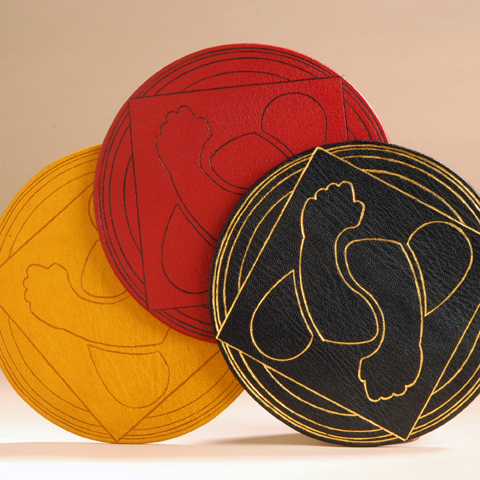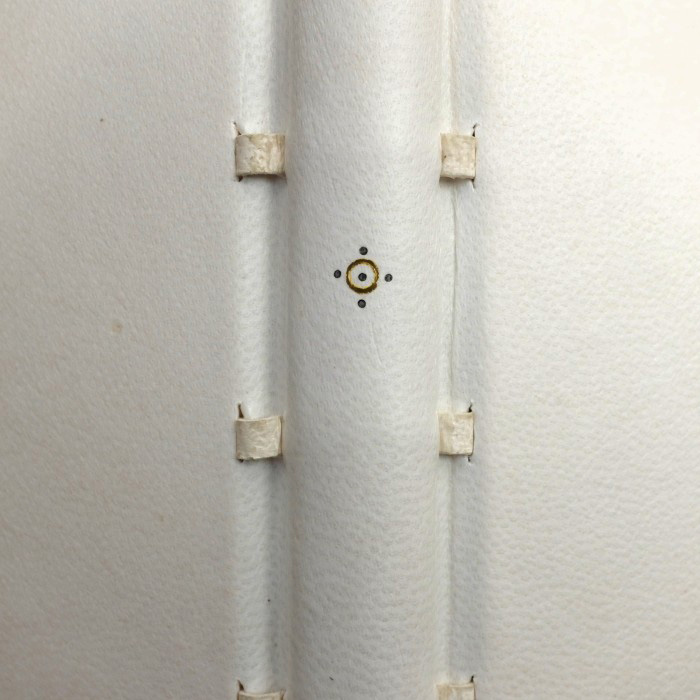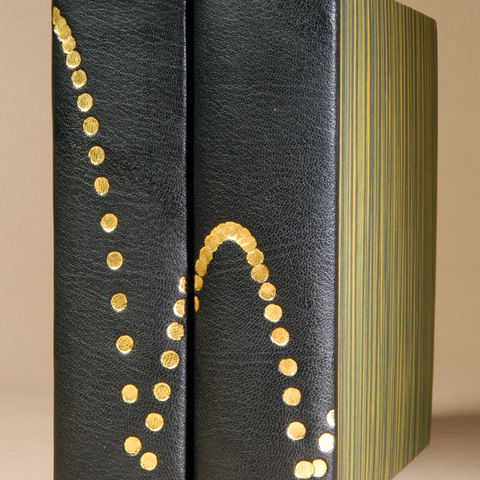
These practice pieces demonstrate the differences between blind tooling (the yellow disk - no color is applied; the heat of the tool combined with a small amount of moisture in the leather darken the image slightly), tooling with carbon (the image blackens), and gold (23K gold leaf applied with egg albumen glaire).
This is a binding I did for The Coast of Chicago, a book of short stories by Stuart Dybek. It is in the single flexible style, covered in calfskin I dyed by hand. I tooled it with carbon for the title and 23K gold leaf for the follow-the-dots design.
This is a binding I did for The Coast of Chicago, a book of short stories by Stuart Dybek. It is in the single flexible style, covered in calfskin I dyed by hand. I tooled it with carbon for the title and 23K gold leaf for the follow-the-dots design.
This is a binding I did for The Coast of Chicago, a book of short stories by Stuart Dybek. It is in the single flexible style, covered in calfskin I dyed by hand. I tooled it with carbon for the title and 23K gold leaf for the follow-the-dots design.
One of the greatest things about my job is the books I get to read (occasionally). When I do personal, design oriented work, which is not often, I get to read amazing books such as James Baldwin's Go Tell It on the Mountain. The cover onlays are made of dyed and layered paper-thin (or thinner) pieces of leather, and the design represents the climax of the novel.
I tried a new style of edge gilding on this book. Doing personal work such as this helps me practice techniques I eventually use in my clients' work.
This binding resulted in part from a class I took in parchment conservation in the summer of 2015. I learned about the history and making of parchment, as well as how it behaves when moistened or wetted, and these lessons helped me understand how it might be used as a covering material. Parchment has some ideal qualities as a binding material: it is naturally alkaline and hard-wearing, and when combined with gold decoration, can be quite lovely.
This binding resulted in part from a class I took in parchment conservation in the summer of 2015. I learned about the history and making of parchment, as well as how it behaves when moistened or wetted, and these lessons helped me understand how it might be used as a covering material. Parchment has some ideal qualities as a binding material: it is naturally alkaline and hard-wearing, and when combined with gold decoration, can be quite lovely.
This binding resulted in part from a class I took in parchment conservation in the summer of 2015. I learned about the history and making of parchment, as well as how it behaves when moistened or wetted, and these lessons helped me understand how it might be used as a covering material. Parchment has some ideal qualities as a binding material: it is naturally alkaline and hard-wearing, and when combined with gold decoration, can be quite lovely.
This is a leather rounded-spine box with very thin inlays of leather, called Ascona inlays, for the pussywillow design.
This is a leather rounded-spine box with very thin inlays of leather, called Ascona inlays, for the pussywillow design.
This is a leather rounded-spine box with very thin inlays of leather, called Ascona inlays, for the pussywillow design.
This two-volume set of photo albums features what's known as a linked spine design. The design is based on Berenice Abbot's series of science-themed photographs from the 1950s. The books were featured in Lark Books's 500 Handmade Books in 2008.
All the books in this series of photos show variations on the millimeter binding. This is a style of binding that developed in northern Europe during the world wars, when leather for bookbinding was scarce. Making use of the leather they did have, bookbinders placed only tiny, millimeter-wide strips of it over critical areas, like corners, joints, and headcaps. All the books shown are covered in paste paper I made.
All the books in this series of photos show variations on the millimeter binding. This is a style of binding that developed in northern Europe during the world wars, when leather for bookbinding was scarce. Making use of the leather they did have, bookbinders placed only tiny, millimeter-wide strips of it over critical areas, like corners, joints, and headcaps. All the books shown are covered in paste paper I made.
All the books in this series of photos show variations on the millimeter binding. This is a style of binding that developed in northern Europe during the world wars, when leather for bookbinding was scarce. Making use of the leather they did have, bookbinders placed only tiny, millimeter-wide strips of it over critical areas, like corners, joints, and headcaps. All the books shown are covered in paste paper I made.
All the books in this series of photos show variations on the millimeter binding. This is a style of binding that developed in northern Europe during the world wars, when leather for bookbinding was scarce. Making use of the leather they did have, bookbinders placed only tiny, millimeter-wide strips of it over critical areas, like corners, joints, and headcaps. All the books shown are covered in paste paper I made.
All the books in this series of photos show variations on the millimeter binding. This is a style of binding that developed in northern Europe during the world wars, when leather for bookbinding was scarce. Making use of the leather they did have, bookbinders placed only tiny, millimeter-wide strips of it over critical areas, like corners, joints, and headcaps. All the books shown are covered in paste paper I made.



















